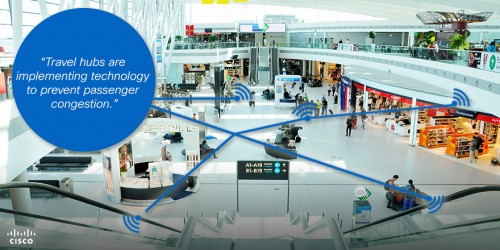
#DigitalCitizen Series: Trains, Planes, and Automobiles
Transportation and Mass Transit
Motorways, public transport, bridges, railways, ports, airports and their cyber networks are all a part of critical transportation infrastructure, which is essential to the daily function of 21st century society. As urban population centres grow, so does the demand on transportation infrastructure. More and more commuters are shifting from using roads to rail, bus and other means of public transportation.
This shift is changing the role of public transport and the station hubs that support them. Commuters demand ‘always-on’ connectivity – transportation operators must assume that everything and everyone needs to be connected to a network. But the growth of connected devices within transportation ecosystems dramatically increases the number of potential attack vectors. And as we open our transportation networks – both physical and digital – to more points of connectivity, concerns of vulnerability to increasingly sophisticated direct and indirect cyber attacks are on the rise.
The Internet of Everything is forming the foundation of the digital transformation of connected roads, rail, buses, airports and ports all around the world. Improving global transportation systems increases mobility and improves safety and security for millions of people, in an environmentally conscious manner. Transportation agencies and organisations are developing digital strategies that are changing the overall passenger experience, improving productivity, and generating new revenue streams; fuelling the overall evolution of the industry.
In today’s post our digital citizen is really on the move. It’s that time of year when the world and his wife are all hitting the roads, the airports, and trains, heading for that highly anticipated holiday destination.
Rushed packing is complete; our digital citizen is ready to start the journey toward work-free liberation. But travel – by car, train, and plane – is challenging, especially during the holiday rush, right? Wrong. Not in the world where digitized transportation systems are enabling a seamless passenger experience.
First, our citizen must head to the airport by car. Despite the time of year, traffic is efficient because the transportation authorities are on high alert to keep traffic and transit running smoothly. Much like Utah’s Department of Transportation which has implemented digital initiatives that have created a highly granular understanding of transportation systems and improved daily management of their roads and in the infrastructure planning process.
But a smart phone alert just interrupted the citizen’s smooth sailing, there’s a pattern of slow traffic up ahead due to the brilliantly planned roadworks that coincide with the busiest time of the year! Not to worry, a slight reroute around the alert’s mapped view of the construction site and we’re off again. Like over 80 percent of Texas drivers, our citizen was pleased with pre-emptive notifications that allowed for proactive traffic avoidance. After all no one likes looking at mile after mile of empty roadworks!
Our digital citizen has made it to the airport. And this is typically about the time that one would spot it, enemy number one: the dreaded lines that snake around the airline check-in counters and the security checkpoints. Not today and not for our digital citizen. Travel hubs, like Copenhagen Airport, are adopting technology to monitor and prevent passenger congestion, this means less time in queues and more time to relax, shop and find some pre-flight snacks.
A smooth flight and a catnap later, and our citizen arrives at their almost-final destination. The citizen then hops on the next mode of transportation, the train.
Cities like Dubai are adopting digital strategies to fit the growing transit needs as more and more community members are turning to public transportation for means of everyday travel. Relaxed and feeling comfortable with the safety of the journey, because like Metrolink in Los Angeles, this railway is using technology to avoid accidents and unforeseen complications.
The onslaught of other passengers boarding the train wakes our citizen again. With the public transit system providing reliable and plentiful timetables, clean trains, and simple ticketing procedures, why wouldn’t the train be packed? At the end of their journey, like 85-90 percent of Seoul travelers, our citizen is very satisfied with the overall public transportation experience.
Communities are learning how to adjust the critical needs for their transportation networks as they evolve into centres of human coalescence and interaction. This trend is setting up public transportation and mass transit to be the backbone of the world’s smartest cities, which aim to improve the quality of life of citizens, residents, and visitors, while supporting economic development and attracting business and workforce talent.
Next Stop
Stay tuned for next Wednesday’s post to experience a day on the bay with our digital citizen. And be sure to check back each week as we explore new themes, challenges and observations.
Additionally, you can click here and register now to get your IoE questions answered on how to become the next digital community.
Finally, we invite you to be a part of the conversation by using the hashtag #DigitalCitizen and by following @CiscoGovt on Twitter.
For more information and additional examples, visit our Cisco Connected Transportation, Smart+Connected Communities page and our Government page on Cisco.com.!
Tags:- #DigitalCitizen
- #DigitalTransformation
- #SmartConnectedCity
- Government
- Internet of Things (IoT)
- public sector
- smart cities
- Smart+Connected Communities
1 Comments





To start with, our resident must make a beeline for the air terminal via auto. Regardless of the season of year, activity is productive in light of the fact that the transportation powers are on high aware of keep movement and travel running easily. Much like Utah’s Department of Transportation which has executed advanced activities that have made an exceptionally granular comprehension of transportation frameworks and enhanced every day administration of their streets and in the foundation arranging procedure.
Visit Our Site